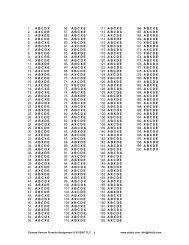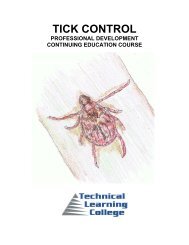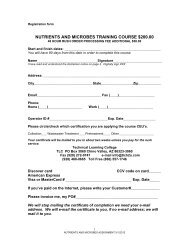Pump Primer 1 $100 - 8 Hours - Technical Learning College
Pump Primer 1 $100 - 8 Hours - Technical Learning College
Pump Primer 1 $100 - 8 Hours - Technical Learning College
Create successful ePaper yourself
Turn your PDF publications into a flip-book with our unique Google optimized e-Paper software.
Variations<br />
Things are complicated by the variation of the density of water with temperature, and also by the<br />
confusion that gave us the distinction between cc and ml. The milliliter is the volume of 1.0 g of<br />
water at 4°C, by definition. The actual volume of 1.0 g of water at 4°C is 0.999973 cm3 by<br />
measurement. Since most densities are not known, or needed, to more than three significant<br />
figures, it is clear that this difference is of no practical importance, and the ml can be taken<br />
equal to the cc. The density of water at 0°C is 0.99987 g/ml, at 20° 0.99823, and at 100°C<br />
0.95838. The temperature dependence of the density may have to be taken into consideration<br />
in accurate work. Mercury, while we are at it, has a density 13.5955 at 0°C, and 13.5461 at<br />
20°C.<br />
The basic idea in finding specific gravity is to weigh a sample in air, and then immersed in<br />
water. Then the specific gravity is W/ (W - W'), if W is the weight in air, and W' the weight<br />
immersed. The denominator is just the buoyant force, the weight of a volume of water equal to<br />
the volume of the sample. This can be carried out with an ordinary balance, but special<br />
balances, such as the Jolly balance, have been created specifically for this application. Adding<br />
an extra weight to the sample allows measurement of specific gravities less than 1.<br />
Pycnometer<br />
A pycnometer is a flask with a close-fitting ground glass stopper with a fine hole through it, so a<br />
given volume can be accurately obtained. The name comes from the Greek word meaning<br />
"density." If the flask is weighed empty, full of water, and full of a liquid whose specific gravity is<br />
desired, the specific gravity of the liquid can easily be calculated. A sample in the form of a<br />
powder, to which the usual method of weighing cannot be used, can be put into the pycnometer.<br />
The weight of the powder and the weight of the displaced water can be determined, and from<br />
them the specific gravity of the powder.<br />
The specific gravity of a liquid can be found with a collection of small weighted, hollow spheres<br />
that will just float in certain specific gravities. The closest spheres that will just float and just sink<br />
put limits on the specific gravity of the liquid. This method was once used in Scotland to<br />
determine the amount of alcohol in distilled liquors. Since the density of a liquid decreases as<br />
the temperature increases, the spheres that float are an indication of the temperature of the<br />
liquid. Galileo's thermometer worked this way.<br />
Hydrometer<br />
A better instrument is the hydrometer, which consists of a weighted float and a calibrated stem<br />
that protrudes from the liquid when the float is entirely immersed. A higher specific gravity will<br />
result in a greater length of the stem above the surface, while a lower specific gravity will cause<br />
the hydrometer to float lower.<br />
The small cross-sectional area of the stem makes the instrument very sensitive. Of course, it<br />
must be calibrated against standards. In most cases, the graduations ("degrees") are arbitrary<br />
and reference is made to a table to determine the specific gravities. Hydrometers are used to<br />
determine the specific gravity of lead-acid battery electrolyte, and the concentration of antifreeze<br />
compounds in engine coolants, as well as the alcohol content of whiskey.<br />
<strong>Pump</strong> <strong>Primer</strong> I Course © 12/1/2012 (866) 557-1746 www.ABCTLC.com<br />
38
















